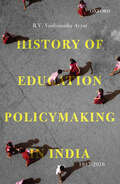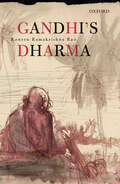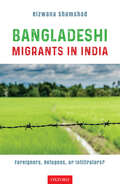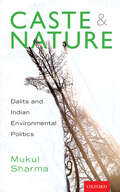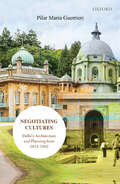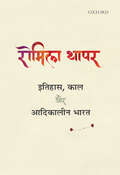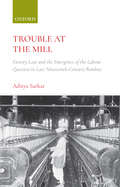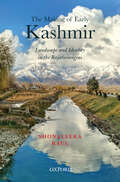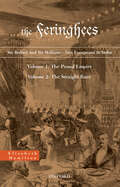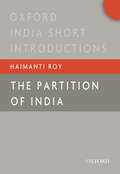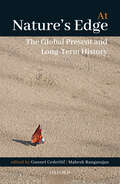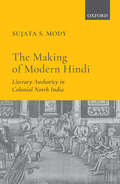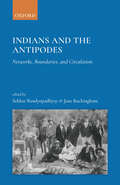- Table View
- List View
History of Education Policymaking in India, 1947–2016
by R. V. AyyarThis book comprehensively chronicles the history of the education policymaking in India from 1947 to 2016 with a focus on the developments after 1964 when the Kothari Commission was constituted. The book is informed by the rare insights acquired by the author while making policy at the state, national, and international levels of governance. Another distinguishing feature of this book lies in the attention it pays to the process and politics of policymaking and the larger setting—or, to use jargon, the political and policy environment— in which policies were made at different points of time. The author brings out a crucial analysis of the Indian educational system against the backdrop of national and global political, economic, and educational developments. Two other distinguishing features of the book are the systematic treatment of the regulation of education and the role of judiciary in the making and implementation of education policies.
Delhi in Transition, 1821 and Beyond: Mirza Sangin Beg’s Sair-ul Manazil
by Shama Mitra ChenoyCommissioned by the English East India Company to write about contemporary nineteenth-century Delhi, Mirza Sangin Beg walked around the city to capture its highly fascinating urban and suburban extravaganza. Laced with epigraphy and fascinating anecdotes, the city as ‘lived experience’ has an overwhelming presence in his work, Sair-ul Manazil. Interestingly, Beg made no attempt to ‘monumentalize’ buildings; instead, he explored them as spaces reflective of the socio-cultural milieu of the times. Delhi in Transition is the first comprehensive English translation of Beg’s work, which was originally published in Persian. It is the only translation to compare the four known versions of Sair-ul Manazil, including the original manuscript located in Berlin, which is being consulted for the first time. Shama Mitra Chenoy’s exhaustive introduction and extensive notes, along with the use of varied styles in the book to indicate the multiple sources of the text, contextualize Beg’s work for the reader and engage him with the debate concerning the different variants of this unique and eclectic work.
Burden of History: Assam and the Partition—Unresolved Issues
by Udayon MisraThe Partition of India left in its wake far-reaching consequences for the northeastern state of Assam. Appearing to be caught in a time warp, the region continues to grapple with questions that engaged the public mind more than seven decades ago, before and immediately after the Partition. Alarmingly, issues such as immigration, demographic change, language, and identity have not only retained their relevance but have also gained an extra edge today. In this volume, the author outlines the present contentious issues confronting the state. Explaining the roots of these disputes and how the challenge posed by Assam held serious consequences for the nation as a whole, this work examines the developments that occurred in the years preceding Independence and the Partition. These developments have etched their effect on the society, politics, and economy of Assam, along with the entire northeastern region, in an indelible manner. As the volume reveals, the burden of those momentous years still rests heavily on Assam’s contemporary political scenario.
Gandhi’s Dharma
by Koneru Ramakrishna RaoWhen asked about his message to the world, the Mahatma famously said, ‘My life is my message.’ In him there was no room for contradiction between thought and action. His life in its totality is a series of experiments to convert dharma, moral principles, into karma, practices in action. Gandhi believed that development is a dialectical process stemming from the antinomy of two aspects latent within every individual—the brute and the divine. While the former represents instinct-driven behaviour, the latter is one’s true self, which is altruistic. Gandhi described this process in different fields, most of which are relevant even today. Gandhi’s Dharma is an overview of Mahatma Gandhi—his person, philosophy, and practices. The author asserts that the basic principles governing Gandhi’s thoughts—satya, ahimsa, and sarvodaya—are not relics of the past. Nor are his thoughts an obsolete list of rules. Gandhi’s ideas are dynamic principles perpetually in the making, perfectly adaptable to contemporary life.
Bangladeshi Migrants in India: Foreigners, Refugees, or Infiltrators?
by Rizwana ShamshadIn January 2011, Felani Khatun was shot dead while attempting to cross the border from India to Bangladesh. Her body remained hung on the fence as a warning to those who illegally crossed an international border. Migration to India from the current geographical and political entity called Bangladesh is more than a century old and had begun long before the nation states were created in South Asia. Often termed as ‘foreigners’ and ‘infiltrators’, Bangladeshi migrants such as Felani find their way into India for the promise of a better future. Post 1971, there has been a steady movement of people from Bangladesh into India, both as refugees and for economic need, making this migration a complex area of inquiry. This book focuses on the contemporary issue of undocumented Bangladeshi migration to the three Indian states of Assam, West Bengal, and Delhi, and how the migrants are perceived in light of the ongoing discourses on the various nationalisms in India. Each state has a unique history and has taken different measures to respond to Bangladeshi migrants present in the state. Based on extensive fieldwork and insightful interviews with influential members from key political parties, civil society organizations, and Hindu and ethnic nationalist bodies in these states, the book explores the place and role of Bangladeshi migrants in relation to the inherent tension of Indian nationalism.
Caste and nature: Dalits and Indian Environmental Policies
by Mukul SharmaRarely do Indian environmental discourses examine nature through the lens of caste. Whereas nature is considered as universal and inherent, caste is understood as a constructed historical and social entity. Mukul Sharma shows how caste and nature are intimately connected. He compares Dalit meanings of environment to ideas and practices of neo-Brahmanism and certain mainstreams of environmental thought. Showing how Dalit experiences of environment are ridden with metaphors of pollution, impurity, and dirt, the author is able to bring forth new dimensions on both environment and Dalits, without valourizing the latter’s standpoint. Rather than looking for a coherent understanding of their ecology, the book explores the diverse and rich intellectual resources of Dalits, such as movements, songs, myths, memories, and metaphors around nature. These reveal their quest to define themselves in caste-ridden nature and building a form of environmentalism free from the burdens of caste. The Dalits also pose a critical challenge to Indian environmentalism, which has, until now, marginalized such linkages between caste and nature.
Tabiyat: Medicine and Healing in India and Other Essays
by Farokh Erach UdwadiaThis book, aptly titled ‘Tabiyat’ which translates to ‘health’, ‘nature’, ‘temperament’ or ‘disposition’, is a collection of nine masterly and thought-provoking essays which explore some important discoveries, dwelling on their relevance in our daily lives. Including essays on War and Medicine, Medical Ethics, Music and Medicine, Nursing and Death, the book encompasses various fields of human endeavour and aspects of life and living which influence and impact medicine.
Text and Tradition in Early Modern North India
by Tyler Williams Anshu Malhotra John Stratton HawleyEarly modern India—a period extending from the fifteenth to the late eighteenth century—saw dramatic cultural, religious, and political changes as it went from Sultanate to Mughal to early colonial rule. Witness to the rise of multiple literary and devotional traditions, this period was characterized by immense political energy and cultural vibrancy. Text and Tradition in Early Modern North India brings together recent scholarship on the languages, literatures, and religious traditions of northern India. It focuses on the rise of vernacular languages as vehicles for literary expression and historical and religious self-assertion, and particularly attends to ways in which these regional spoken languages connect with each other and their cosmopolitan counterparts. Hindu, Muslim, and Jain idioms emerge in new ways, and the effect of the volume as a whole is to show that they belong to a single complex cultural conversation.
Locating the Medical: Explorations in South Asian History
by Rohan Deb Roy Guy N.A. AttewellThis volume interrogates the foundational categories that have come to define medical science in modern South Asia. It seeks to probe issues such as what constitutes the ‘medical’, in which context, and who defines it. This is achieved through case studies that range from the nineteenth to twenty-first centuries, from colonial Bengal and British Burma to present-day Andaman Islands and Ladakh. By examining the close interactions between political authorities, corporeal knowledge, and objects of governance in a sustained manner, the domains of the medical and the non-medical are revealed to be more blurred and porous than apparent. This provides us with new perspectives on the co-production of medicine and social worlds by actors and agencies in specific times and places.
The New Frontier: Merit vs. Caste in the Indian IT Sector
by Marilyn FernandezDoes the burgeoning Indian Information Technology (IT) sector represent a deviation from the historical arc of caste inequality or has it become yet another site of discrimination? Those who claim that the sector is caste-free believe that IT is an equal opportunity employer, and that the small Dalit footprint is due to the want of merit. But they fail to consider how caste inequality sneaks in by being layered on socially constructed ‘pure merit’, which favours upper castes and other privileged segments, but handicaps Dalits and other disadvantaged groups. In this book, Fernandez describes how the practice of pure and holistic merit are deeply embedded in the social, cultural, and economic privileges of the dominant castes and classes, and how caste filtering has led to the reproduction of caste hierarchies and consequently the small Dalit footprint in Indian IT.
Negotiating Cultures: Delhi’s Architecture and Planning from 1912 to 1962
by Pilar Maria GuerrieriFocusing on one of the largest megacities in the world—Delhi—this volume is a rare peek into the ineluctable process of hybridization between Indian and ‘other’ cultures within its local architecture and urban planning. The book explores a segment of the history of Delhi from 1912 through 1962, when the contemporary megacity was born, making a comparison between pre- and post-Independence, which is relatively neglected in academia. The author traces architectural and urban elements of the city of Delhi to understand how foreign developmental models were indigenized, the resistance encountered in the process, and finally their adaptation to local architectural contexts. Highlighting the complexities of ‘multiple Delhis’ with different or simultaneous cultural influences as well as with the various ways those influences have been interpreted or contextualized, the author offers a fresh insight into what is happening in Delhi’s globalized built environment nowadays. The book aims to unearth the social relations emerging from the constant flux in style of architecture and its related elements in an urbanized area.
Sedition in Liberal Democracies
by Anushka SinghExamining the relationship between sedition and liberal democracies, particularly in India, this book looks at the biography of sedition laws, its contradictory position against free speech, and democratic ethics. Recent sedition cases registered in India show that the law in its wide and diverse deployment was used against agitators in a community-based pro-reservation movement, group of university students for their alleged ‘anti-national’ statements, anti-liquor activists, and anti-nuclear movement, to name a few. Set against its contemporary use, this book has used sedition as a lens to probe the fate of political speech in liberal democracy. The lived reality of the law of sedition in changing anthropological sites is juxtaposed with its positivist existence. Anushka Singh uses a comparative framework keeping in focus the Indian experience backed by fieldwork in Haryana, Maharashtra, and Delhi, and includes a comparative perspective from England, the USA, and Australia to contribute to debates on sedition within liberal democracies at large, especially in the wake of the proliferation of counter-terror legislations.
Itihas, Kaal aur Adikalin Bharat
by रोमिला थापरIn this book, Romila Thapar examines the link between time and history through the use of cyclic and linear concepts of time. While the former occurs in a cosmological context, the latter is found in familiar historical forms. The author argues for the existence of historical consciousness in early India, on the evidence of early texts. This is the Hindi edition translated from English.
Trouble at the Mill: Factory Law and the Emergence of the Labour Question in Late Nineteenth-Century Bombay
by Aditya SarkarThe colonial administration passed a Factory Act in 1881, producing the first official definition of ‘factory’ in modern Indian history—as a workplace using steam power and regularly employing over 100 workers. In 1891, the Act was amended: factories were redefined as workplaces employing over 50 workers; the upper age limit of legal ‘protection’ was raised; weekly holidays were established; and women mill-workers were brought within its ambit. Sarkar analyses the two versions of the Act and reveals the tensions inherent within the project of protective labour regulation. Combining legal and social history, he identifies an emergent ‘factory question’. The cotton mill industry of Bombay, long considered as one of the birthplaces of modern Indian capitalism, is the principal focal point of his investigation. Factory law, though experienced as a minor official initiative, connected with some of the most potent ideological debates of the age. Trouble at the Mill explores a shifting set of themes and raises questions rarely thematized by labour historians—the ideologies of factory reform, the politics of factory commissions, the routines of factory inspection, and the earliest waves of strike action in the cotton textile industry in the last quarter of the nineteenth century.
The Making of Early Kashmir: Landscape and Identity in the Rajatarangini
by Shonaleeka KaulWhat is history? How does a land become a homeland? How are cultural identities formed? The Making of Early Kashmir explores these questions in relation to the birth of Kashmir and the discursive and material practices that shaped it up to the 12th century CE. Reinterpreting the first work of Kashmiri history, Kalhana’s Rajatarangini, this book argues that the text was history not despite being traditional Sanskrit poetry but because of it. It elaborated a poetics of place, implicating Kashmir’s sacred geography, a stringent critique of local politics, and a regional selfhood that transcended the limits of vernacularism.Combined with longue durée testimonies from art, material culture, script, and linguistics, this book jettisons the image of an isolated and insular Kashmir. It proposes a cultural formation that straddled the Western Himalayas and the Indic plains with Kashmir as the pivot. This is the story of the connected histories of the region and the rest of India.
There and Back: Twelve of the Great Routes of Human History
by Stewart GordonThough travelling is lauded as a means of enriching our lives, the emphasis is generally on the destination rather than the journey. Yet, throughout human history, routes have ferried not just people but books, scrolls, and art, in addition to armies, ambassadorial entourages, slaves, brides, and pilgrims. The interaction of people on routes generated surprising innovations. Through myths, memoirs, and songs associated with twelve such great routes across five continents, historian Stewart Gordon shows how they captured the collective imagination and shaped the expectations of generations of would-be travellers.
THE EMPIRE OF APOSTLES: Religion, Accommodatio, and the Imagination of Empire in Early Modern Brazil and India
by Ananya ChakravartiThe Portuguese encounter with the peoples of South Asia and Brazil set foundational precedents for European imperialism. Jesuit missionaries were key participants in both regions. As they sought to reconcile three commitments—to local missionary spaces, to a universal Church, and to the global Portuguese empire—the Jesuits forged a religious vision of empire. Ananya Chakravarti explores both indigenous and European experiences to show how these missionaries learned to negotiate everything with the diverse peoples they encountered and that nothing could simply be imposed. Yet Jesuits repeatedly wrote home in language celebrating triumphal impositions of European ideas and practices upon indigenous people. In the process, while empire was built through distinctly ambiguous interactions, Europeans came to imagine themselves in imperial moulds. In this dynamic, in which the difficult lessons of empire came to be learned and forgotten repeatedly, Chakravarti demonstrates an enduring and overlooked characteristic of European imperialism.
The Feringhees: Sir Robert and Sir William—Two Europeans in India Volume 1: The Proud Empire; Volume 2: The Straight Race
by Elizabeth HamiltonA stiff upper lip, steely eyes and a cold heart is often how the English imperialist is pictured in popular imagination. Drawing from memoirs, commentaries and family letters, Elizabeth Hamilton brings forth an alternative portrayal of her ancestors, Sir Robert Hamilton and Sir William Barton. Their careers in India are set against the momentous events of their times to present a different side of the colonialists of a quiet people, dedicated to the tradition of upholding the law and avoiding conflict. Volume I, The Proud Empire, traces the life of Sir Robert Hamilton, from the beginning of his career under the watchful eye of his father, up until his retirement. Occupying multiple roles such as the Resident of Indore and Agent to the Governor General in the Central Provinces, he is seen interacting with various prominent Indian figures such as the Rani of Jhansi, Tantya Tope and Nana Sahib. The picture of the arrogant imperialist fades away to be replaced by that of someone keen to make a difference to the society he was working in, who encourages good governance, mends ties in the midst of escalating tensions and must recover cities occupied by insurgents, all the while shadowed by the burden of great personal losses. Volume II, The Straight Race, tracks Sir William Barton’s career in the early twentieth century. Starting in the Punjab and the North-West Frontier, he later served as Resident in the well-administered states of Mysore and Hyderabad, where he stood up to the Nizam, doing his best to set the administration on a less corrupt footing. Retirement did not deter Sir William’s close interest in Indian affairs; he returned twice on tour as an advisor to electrical companies and travelled with a Ministry of Supply mission during the Second World War. With three books and many articles for newspapers and journals on the subject, India remained an integral part of his life.
Indian Army and the First World War: 1914–18
by Kaushik RoyAccustomed to conducting low-intensity warfare before 1914, the Indian Army learnt to engage in high-intensity conventional warfare during the course of World War I, thereby exhibiting a steep learning curve. Being the bulwark of the British Empire in South Asia, the ‘brown warriors’ of the Raj functioned as an imperial fire brigade during the war. Studying the Indian Army as an institution during the war, Kaushik Roy delineates its social, cultural, and organizational aspects to understand its role in the scheme of British imperial projects. Focusing not just on ‘history from above’ but also ‘history from below’, Roy analyses the experiences of common soldiers and not just those of the high command. Moreover, since society, along with the army, was mobilized to provide military and non-military support, this volume sheds light on the repercussions of this mass mobilization on the structure of British rule in South Asia. Using rare archival materials, published autobiographies, and diaries, Roy’s work offers a holistic analysis of the military performance of the Indian Army in major theatres during the war.
Indian Suffragettes: Female Identities and Transnational Networks
by Sumita MukherjeePopular depictions of campaigns for women’s suffrage in films and literature have invariably focused on Western suffrage movements. The fact that Indian women built up a vibrant suffrage movement in the twentieth century has been largely neglected. The Indian ‘suffragettes’ were not only actively involved in campaigns within the Indian subcontinent, they also travelled to Britain, America, Europe, and elsewhere, taking part in transnational discourses on feminism, democracy, and suffrage. Indian Suffragettes focuses on the different geographical spaces in which Indian women were operating. Covering the period from the 1910s until 1950, it shows how Indian women campaigning for suffrage positioned themselves within an imperial system and invoked various identities, whether regional, national, imperial, or international, in the context of debates about the vote. Significantly, this volume analyses how the global connections that were forged influenced social and political change in the Indian subcontinent, highlighting Indian mobility at a time when they were colonial subjects.
Art Attacks: Violence and Offence-Taking in India
by Malvika MaheshwariSince the end of the 1980s in India, self-styled representatives of a variety of ascriptive groups—religious, caste, regional, and linguistic—have been routinely damaging artworks, disrupting their exhibition, and threatening and assaulting artists and their supporters. Often, these acts are claimed to be a protest against allegedly ‘hurtful’ or ‘offensive’ artworks, wherein its regularity and brazenness has led to an intensifying sense of fear, frustration, and anger within the art world. Art Attacks tells the story of this phenomenon and maps the concrete political transformations that have informed the dynamic unfolding of violent attacks on artists. Based on extensive interactions with offence-takers, assailants, and artists, the author argues that these attacks are not simply ‘anti-democratic’ but are dependent in perverse ways on the very logics of democracy’s functioning in India. At the same time, they have been contained, at least until now, by this very democratic system, which has prevented the spiralling of attacks into an outright condition of art plunder.
The Partition of India (Oxford India Short Introductions)
by Haimanti RoyWas the Partition of India inevitable? Was it a ‘clash of civilizations’ between Hindus, Muslims, and Sikhs of the Indian subcontinent? Was the Partition a momentous event or a long-drawn-out messy process? Were the experiences of uprooting, violence, and rehabilitation in the divided provinces of Bengal and Punjab the same? What are the multiple legacies and memories of the Partition? More than 70 years have passed since this upheaval, yet we continue to grapple with such questions. The Partition remains in the memories of those families and individuals who lived through the trauma of violence and uprooting, the loss of life, and the travails of survival. This short introduction provides a comprehensive account of the causes, experience, and aftermath of this division and acquaints its readers with major debates in a succinct manner. It situates the history and politics of the division within the broader histories of colonial and postcolonial South Asia and draws attention to the multiplicity of meanings of 1947 and their relevance in framing and understanding contemporary challenges in South Asia.
At Nature’s Edge: The Global Present and Long-Term History
by Gunnel Cederlöf Mahesh RangarajanIn an epoch when environmental issues make the headlines, this is a work that goes beyond the everyday. Ecologies as diverse as the Himalayas and the Indian Ocean coast, the Negev desert and the former military bases of Vietnam, or the Namib desert and the east African savannah all have in common a long-time human presence and the many ways people have modified nature. With research covering countries from Asia, Africa, and Australia, the authors come together to ask how and why human impacts on nature have grown in scale and pace from a long pre-history. The chapters in this volume illumine specific patterns and responses across time, going beyond an overt centring of the European experience. The tapestry of life and the human reshaping of environments evoke both concern and hope, making it vital to understand when, why, and how we came to this particular turn in the road. Eschewing easy labels and questioning eurocentrism in today’s climate vocabulary, this is a volume that will stimulate rethinking among scholars and citizens alike.
The Making of Modern Hindi: Literary Authority in Colonial North India
by Sujata S. ModyIn the early twentieth century, British imperialism in India was at its peak and anti-colonial sentiments were on the rise. The nationalist desire for cultural self-identification was gaining ground and an important articulation of this was the demand for a national language and literature to represent a modern India. It was in this context that Mahavir Prasad Dwivedi, a novel, daring, and contentious litterateur, launched his multimedia campaign of constructing a new Hindi literary establishment. As the long-time editor of the Hindi journal Sarasvatī, Dwivedi’s influence was so far-reaching that this period of modern literature in Hindi is known as the Dwivedi era. However, he had to face stiff opposition as well. Sujata Mody’s book sheds light on the interactions between Dwivedi and his supporters and detractors and shows how Dwivedi’s responses to challenges were pragmatic and strategically varied. The Making of Modern Hindi presents Dwivedi as a dynamic and influential arbiter of literary modernity whose exchanges with competing authorities are an important piece in the history of Hindi literature.
Indians and the Antipodes: Networks, Boundaries, and Circulation
by Sekhar Bandyopadhyay Jane BuckinghamThe Indian diaspora in Australia and New Zealand represents a successful ethnic community making significant contributions to their host societies and economies. However, because of their small number—slightly more than half a million— they rarely find mention in the global literature on Indian diaspora. The present volume seeks to remedy this oversight. Charting the chequered 250-year-old history of both the ‘old’ and the ‘new’ diaspora in the antipodes, the chapters narrate the stories of labourers who journeyed under the pressure of colonial capital and post-war professional migrants who went in search of better opportunities. In the context of the ‘White Australia’ and ‘White New Zealand’ policies designed to stem the arrival of Asians in the early twentieth century, we read of the complex survival stratagems adopted by migrants to circumvent the stringent insular world view of the existing white settlers in these countries. Together with stories of the collective suffering and struggles of the diaspora, we are presented with stories of individual resilience, enterprise, and social mobility.
